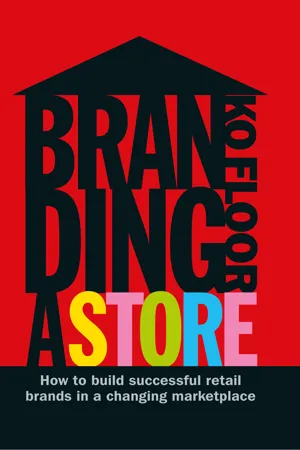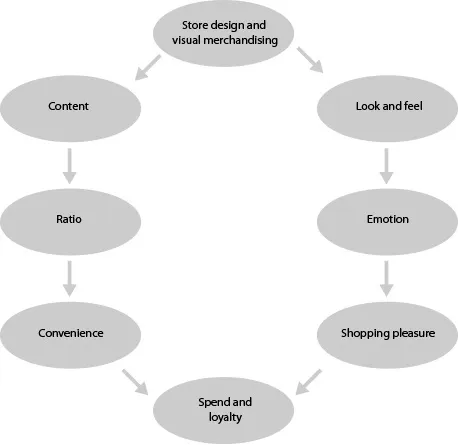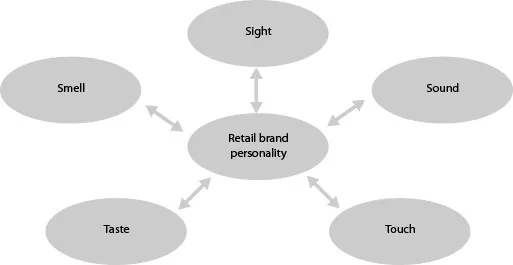![]()
11. IN-STORE COMMUNICATIONS: HIGHER SPEND AND LOYALTY
Most buying decisions take place in the store. A retailer therefore has every opportunity to work on its brand identity in the store, as a manufacturer does not. Retailers face the challenge of focusing on all the senses. Almost all in-store communication is now visual. The result is sometimes visual pollution, and consequently some retail brands miss the opportunity to strengthen their emotional bond with their customers because of all the clutter. However, a strong retail brand will recognize that its personality has to be translated into distinguishable style attributes like colours, shapes, materials, sounds, smells and other sensory appeals. By doing this, a retail brand can develop a distinctive look and feel for its in-store communications.
The design of a store is broadly comparable to the packaging of a manufacturer brand. It should communicate the positioning and personality, add value to the merchandise and be efficient and effective. Visual merchandising means bringing the retail brand to life and dramatizing the merchandise offer. Immediately preceding a purchase decision, visual merchandising can be the most powerful, most effective communication tool for a retailer. In reality however, many stores do not make the most of the opportunity to seduce consumers. Many stores are very boring and predictable.
Employees are the link between the customer and the retail brand. They are almost the brand themselves, and can make a real difference in retail. That is why internal branding is so important. Every employee should know exactly what the retail brand stands for.
11.1 The most important medium
The strong competition in the retail sector leads to very low margins on best-selling items in particular. This downward pressure on price can be compensated for (to some degree) by creating an inspiring and inviting shopping environment. In the store a retail brand can communicate and strengthen its positioning. Through visual merchandising and by using the employees, attention can be drawn to unique products. A cheap-looking store design and a simple product presentation can strengthen a low-price positioning. Clear signage, wide aisles and attentive employees can make the shopping experience easier, and of course, the shopping environment also has a big influence on the overall store experience. A retail brand can build up a unique identity through distinctive in-store communications. In-store communications not only strengthen brand positioning, but can also express brand personality. That is why no other medium has as much influence on buying behaviour. However, by no means all retailers realize this. They still pay more attention to store operations than to the shopping environment.
In-store communications can be a very strong medium for every retailer. Even if the positioning mix of a retail brand is similar to that of other retail brands, store design, visual merchandising and employees can still create a very distinctive brand identity. The conversion rate in department stores is often below 50 per cent, because many browsers are insufficiently persuaded to buy something. But these browsers can be persuaded to become buyers through inspiring in-store communications. About 40 to 80 per cent of all in-store purchases are unplanned, and these are likely to be motivated by different kinds of in-store communications: store design, visual merchandising and employees.
In-store communications can also have a big influence on profit, because they can guide, engage, inform, excite and stimulate the customer. If managed well, all touch-points together will give the desired, consistent brand impression. In-store communications can create an environment that enhances the shopping experience, and can help build a retail brand as well. Appealing in-store communications that reflect the brand personality can provide a very strong differential advantage.
Clear, attractive and inspiring in-store communications can make shopping an enjoyable experience. Customers want to be informed and inspired, and are willing to let their buying behaviour be influenced by impulses in the store. The level of influence any in-store communication has on buying behaviour depends on the extent to which the purchase was planned beforehand, however. Some purchases are entirely planned while for others the consumer might be planning to buy a specific type of good, but not yet have selected a specific variety. Perhaps a consumer knows he wants to eat fish for dinner, but does not yet know which kind of fish. In a similar way, the consumer might have chosen a product category, but not a brand. For example, a consumer intends to buy a television, but she still hesitates between a couple of brands. In-store communications can help to influence the consumer to buy one brand over another, or even one product over another.
Finally, there are also impulse purchases in the store that were not planned at all. In Dutch supermarkets the in-store decision rate is as follows (Nauta, 2003):
- Specifically planned (both product and brand planned, and bought according to plan): 20.9 per cent.
- Generally planned (product planned, brand chosen in-store): 22.9 per cent.
- Substitute product or brand (product or brand planned, but the customer decided to buy an alternative in-store): 4.6 per cent.
- Unplanned, impulse (decided entirely in-store): 51.7 per cent.
In other words, some element of around 80 per cent of all purchases in Dutch supermarkets is decided upon in-store. In Belgium, the United Kingdom and Denmark the level is between 70 and 80 per cent. In Germany and Italy it is lower: about 40 and 50 per cent respectively. However, in all these countries the share of purchases that can be influenced by in-store communications is enormous. If retailers apply new technologies, like for example narrowcasting and self-service kiosks, this influence will probably only get bigger. Store design and visual merchandising then complement each other.
Consumers can choose between multiple stores for almost every product they need. In some sectors there is over-capacity, so a retail brand has to attract attention from among a host of other stores. A retailer can clearly differentiate itself from its competitors through a striking store design with a unique look and feel. The store design should reflect and enhance the brand identity. A differentiating store design can create emotions and sensory experiences, because welldesigned stores have their own, distinctive personality. An appealing store design can give the retail brand a face. That is why store design and visual merchandising are extremely important touch-points for a retailer in building a strong brand. They are often the most effective media for retaining customers, and additionally, they can lead to increased sales.
Online retailers cannot control the environment and atmosphere in which consumers are shopping. Consumers sit at home and decide for themselves how they shop. In principle, offline retailers are able
to control the shopping environment as they can create a total brand experience through their store design and visual merchandising. Delivering on the brand promise is the moment of truth in the store. If it communicates consistent brand values and delivers a strong brand promise, the store environment can support the retail brand.
Figure 11.1 Functions of store design and visual merchandising
Store design and visual merchandising can fulfil both rational and emotional wants. The emotional function is mostly about making shopping more fun. The look and feel of the store design and visual merchandising influence the customer’s perception. A pleasant look and feel can lead to a positive emotional response, making shopping more pleasurable. The rational function is mainly about the content of store design and visual merchandising, which makes shopping easier for the consumer.
The look and feel of a store’s design and visual merchandising is about colours, shapes, materials, scents, sound, lighting and other sensory experiences. Together, these elements evoke positive or negative emotions in consumers. In turn, these emotions have a big influence on their buying behaviour. In one store consumers feel at ease; in another they do not. However, store design and visual merchandising also have a rational function. Together they have to create a shopping environment in which customers can shop quickly and easily. A clear layout, clear visual merchandising and clear and easily understood instore communications make shopping easier and save time. Consumers want to be able to find products easily, and these products need to be clearly marked. Furthermore, there should be salespeople available when necessary, and there should not be any queues at the checkout. If a product does not meet expectations, it should be possible to exchange it without any hassle. If all these needs are met, the consumer will likely return.
Store design and visual merchandising, together with merchandise and employees, form the in-store brand experience. For example, Home Depot, the world’s biggest do-it-yourself retail chain, discovered from research (Nardelli, 2004) that the most important factors in its customers’ shopping experiences in its stores are:
- easy shopping, signage, store layout, cleanliness, product presentation: 38 per cent;
- product range, availability, quality, price: 22 per cent;
- store associates: 13 per cent;
- speed of checkout: 10 per cent.
Store design, visual merchandising and employees should be extensions of the retail brand. They give the retail brand a face and a voice. That is what makes store design, visual merchandising and employees strategic weapons, as it were; what makes the positioning and brand personality visible and tangible. Store design has to be more than a neutral background for products. Together with visual merchandising it is an essential part of the total brand identity. The store design, visual merchandising and employees form the brand environment, and can communicate just as strongly as advertising or direct marketing. The consumer needs to be persuaded to buy something via store design and visual merchandising, and the employees then have to close the deal. Alternatively, the store layout and product presentation have to be so clear that consumers can easily make their choice without any help from the sales staff. For example, men who are looking for jeans often give up searching after a couple of minutes if they cannot find the desired model or correct size.
It is not only retail brands in the higher price segment that have to pay attention to their store design and visual merchandising. Low-price brands also use these tools to communicate their desired positioning and brand personality. Stacking it high combined with a high merchandise density communicates low prices. That creates a totally different image from a luxurious clothing store where only a few pieces of clothing are hanging here and there. After all, it is not only prices that determine the consumer’s price perception. The shopping environment in which the merchandise is presented is often just as important. An empty, brightly lit store mostly communicates low prices. In contrast, an expensively decorated store will create a high price image.
There can be a specific problem in designing a store when a retailer also operates vendor shops or concessions. Manufacturers will want to show their own identity as much as possible in their concessions. However, this can be at the expense of the overall store image and the retail brand’s appeal. If the retail brand is not strong enough, concessionaires will impose their own brand design with little regard for the overall store design. But if every shop-in-the-shop has its own identity, the result can be a disorderly store. That is why it is wise for retailers that work with vendor shops to determine clear guidelines for their concessionaires on the design of their concession. For example, in department stores it is obvious that various cosmetics brands have to meet certain guidelines in the design of their counters. Every cosmetic brand has its own identity within certain limits. However, it is also clear that all these brands are part of the overall cosmetics department, and the department store as a whole.
The same problem arises when designing a shopping centre. On one hand all stores in the shopping centre should have the opportunity to communicate their own identity. On the other hand, the shopping centre also needs to communicate a certain overall appeal. After all, the shopping centre has to differentiate itself from other shopping centres. That is why most shopping centres have rules for what the retailers are and are not allowed to do when designing their stores. The Amsterdam Airport Centre goes particularly far in this. The individual stores hardly show their own identity, in contrast to for example the terminals at London Heathrow, where all the stores have the opportunity to create their own look and feel.
11.2 Multi-sensory communication
The challenge of in-store communications is to find the right balance between rationality (saving time) and emotion (shopping fun). That balance can differ for individual store formats. A department store like Bloomingdale’s works more with emotions than Wal-Mart or Target. For the last two, store design and visual merchandising have a mainly functional aspect. But even with this type of store, emotions play a role in the buying process. This is also the case for brands defined by price, where the consumer is not only led by rational considerations. Positive emotions lead to more shopping fun, a longer stay in the store, higher spending and higher store loyalty.
These emotions are brought about through the five senses: sight, touch, sound, smell and taste. In a store customers can see, hear, touch, smell and taste the products. Those opportunities are more limited on a website. A website visit is mainly a visual experience, while a store has a multi-sensory environment. A store cannot compete with a website over the range or amount of information provided, however. But an effective store design and visual merchandising can trigger all the consumer’s senses. Shopping is a multi-sensory experience, so a retail brand should be a sensory experience. Sensory associations can result in a strong emotional engagement and can therefore provide a retail brand with a lead over the competition. They can create a unique look and feel for the retail brand. Multi-sensory communication can even be the key differentiating factor between retail brands. After all, all the impulses of the five senses make up the brand experience.
Figure 11.2 Multi-sensory communication
A few years ago Pier 1, a retail company in the United States that offers casual home furnishings, launched an advertising campaign with store graphics, direct mail and magazine and television advertisements based on its positioning statement ‘Get in touch with your senses’. The campaign evolved from research revealing that its customers valued the sensory shopping experience at Pier 1. Campaign images evoked the sights, smells, sounds, textures and colours that envelop Pier 1 shoppers, especially the striking and specific smell of exotic flowers and spices. This smell makes Pier 1 clearly stand out from the competition.
EatZi’s is a food store where all the senses are stimulated. This Texan retail brand is a combination of a supermarket and a restaurant. At EatZi’s customers can get complete chef-developed, ready-to-heat meals, fresh produce, or the ingredients they need for their favourite recipes. Alternatively its chefs will cook for them while they shop. EatZi’s is each customer’s very own ‘personal chef’. What makes EatZi’s different is that its staff are passionate about food, and it shows. Its customers are a part of the energy created when the chefs prepare their food right in front of them, and they love shopping to a backdrop of classical music and the mouth-watering aromas of garlic, rosemary and freshbaked bread wafting through the air. Everywhere in the store cooks are preparing meals. There’s a real pizza oven, an impressive salad bar and lots of other departments, all with offerings that look just as tasty. At various locations the customer can enjoy a small taste of a dish (‘this is just a sample, not a free lunch’). A lot of attention is paid to the interior and the stores does not economize on salespeople. That is...


